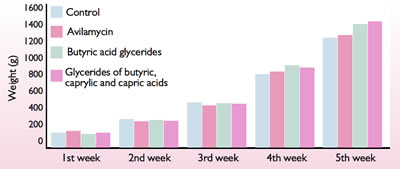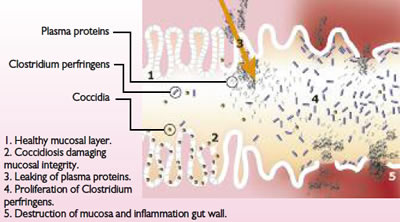
Achieving a healthy gut for a top broiler performance
Good gut health is a pre-requisite to good bird performance, be it in the breeder in rear or the broiler. This article is just as relevant for the breeder farm manager who is rearing breeders as it is for the hatchery manager who in many parts of the world is one of the key sources of technical information for his customers.A newly hatched broiler chick increases its body weight by 25% overnight and by 5000% in a period of five weeks to 2kg body weight. This astonishing performance of the modern chicken comes from:
- Intensive selection for growth rate.
- Attention to health and husbandry.
- Advances in feed formulation.
Therefore, it is especially important to pay attention to the microscopic changes in the mucosal layer of the gut. These changes underpin the efficiency of nutrient assimilation because underneath the mucosa is a vast surface of epithelial cells of the absorptive type essential for the transport of nutrients into the enterocytes.
Health of the gastrointestinal tract is an issue which is especially important for the young birds. There are several possibilities to influence gut health. Butyric acid is known to be a very efficacious feed additive for this purpose.
There are several products on the market providing salts of butyric acid in protected and unprotected forms. Due to the unpleasant persistent odour of butyric acid, protection makes the handling of the product easier.

Fig. 1. Effect of butyric, caprylic and capric acids on weight development in poultry.
Protection of acids
Another reason for protection is to obtain stomach by-pass of butyric acid and subsequent release of the active substance in the small intestine. Encapsulation of acids is a known form of protection. There is also an innovative, beneficial protection in a form of glycerides which is the combination of acids and glycerol.
The glycerol acid compound is not influenced by the pH of the stomach; therefore these compounds reach the small intestine where the gradual release of the undissociated acids through the action of lipases takes place.
It is known that protected butyric acid is an excellent growth promoter as it is an efficient nutrient for the intestinal mucosa increasing the density and length of villi, enlarging the adsorption surface of the intestine. Literature describes the positive effects of butyric acid on breeder and layer production performance and on egg shell quality. Butyric acid is also known as an antibacterial agent against pathogenic micro-organisms including salmonella, clostridia, Escherichia coli etc and as modulator of the intestinal flora supporting useful micro-organisms such as lactobacilli. Butyric acid enhances the reparation of gut wall lesions caused by intestinal diseases and nutritional imbalances. Moreover, butyrate stimulates gastric secretion improving protein and fat digestibility.
The combination of butyric, caprylic and capric acids in the protected glycerides form optimise the influence of butyric acid. Glycerides allow all acids to act as antibacterial in the intestine, furthermore caprylic and capric acids show very strong antimicrobial activity in the higher pH value of the intestine. Moreover, glycerides containing butyric acid and medium chain fatty acids possess nutritional value which is especially important for young animals.
Medium-chain fatty acids, which are saturated fatty acids mainly composed of 8-10 carbons (caprylic and capric acids), have unique nutritional characteristics different from those of long-chain fatty acids. Medium-chain triacylglycerides (MCT) are more readily digested and absorbed than long-chain triacylglycerides (LCT), and easily utilised as energy.
The influence of glycerides of butyric, caprylic and capric acids on growth performance of broiler chickens was described by Antongiovanni et al. (2005) by means of a challenge trial with Clostridium perfringens 5x105 CFU and Eimeria acervulina 103 oocysts. The application dosage of butyric acid glycerides and glycerides of caprylic and capric acids was 2kg/ton feed and 1.5kg/t feed respectively. 10ppm avilamycin was used as a positive control group.
Table 1. Effect of butyric, caprylic and capric acids on growth performance in poultry.
Control |
Avilamycin |
Butyric acid glycerides |
Glycerides of butyric, caprylic and capric acids |
|
| Administration time (days) | 42 |
21 |
21 |
|
| Final weight day 35 (g) | 1278a |
1332a |
1426b (11%) |
1457b (14%) |
| ADWG (g) | 29.52a |
30.80a |
33.04a (11%) |
33.78b (14%) |
| FCR | 2.14ac |
2.29a |
1.9bc (11%) |
1.86c (13%) |
The summarised results of the trial are shown in Table 1 and Fig. 1. Figures with different superscripts are statistically different. The outbreak of necrotic enteritis in all groups was visible after the infection at the third week but birds fed with glycerides had better performances than the negative and positive control groups. The improvement of final body weight, average daily weight gain (ADWG) and feed conversion rate (FCR) of the group fed with glycerides of butyric acid and glycerides of butyric, caprylic and capric acids was around 11% and 14% respectively, compared to the negative control group. Fig. 1 shows the weight development of broilers for the trial period.
The increased resistance of chickens in the groups containing glycerides of butyric, caprylic and capric acids to the infection is due to:
- Better gut and mucosa development.
- Increased capacity of repairing pathogen lesions.
- Microflora control.
Coccidiosis cause mucosal damage, which decreases digestibility and initiates the release of plasma proteins in gut lumen. Plasma proteins are used as a growth substrate for Clostridium perfringens and it leads to necrotic enteritis as shown in Fig. 2.
Optimising gut health is a key to improving animal performance. Young animals, in particular broilers and breeders, need support to develop and maintain a healthy microflora in their intestinal tract. Innovative products, such as the protected form of butyric, caprylic and capric acids are a tool that can be used to optimise poultry performance.

Fig. 2. The damage of intestinal mucosa by coccidia and clostridia.
For Further Product Information Please Visit www.biomin.net
Featured Products

Biotronic®
Naturally ahead in dynamic acidification!
Related Articles

Biotronic®
Efficiency of Biotronic® Product Line in Poultry

Biotronic®
Ascites in poultry

Biotronic® Top3
Biotronic Top3 to Capitalise on Perforizer Effect
Related Services

Mycotoxin Channel
World renowned experts answer mycotxin related questions.

Mycotoxins.info
A wealth of Mycotoxin information at your fingertips

World Nutrition Forum
The future of animal nutrition






